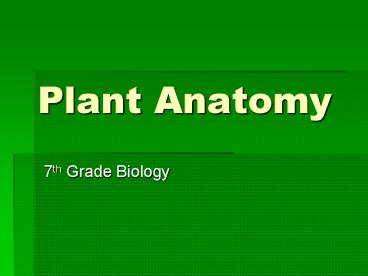Plant Anatomy - PowerPoint PPT Presentation
1 / 41
Title:
Plant Anatomy
Description:
Plant Anatomy 7th Grade Biology But not these kinds of plants Stem Provides structure for the plant Vascular Tissue Xylem The xylem transports water from the root up ... – PowerPoint PPT presentation
Number of Views:424
Avg rating:3.0/5.0
Title: Plant Anatomy
1
Plant Anatomy
- 7th Grade Biology
2
But not these kinds of plants
3
Stem
- Provides structure for the plant
4
Vascular Tissue
- Xylem
- The xylem transports water from the root up the
plant. The xylem is mainly responsible for the
transportation of water and mineral nutrients
throughout the plant. - Phloem
- Phloem is the living tissue that carries organic
nutrients, particularly sucrose, a sugar, to all
parts of the plant where needed.
5
Vascular Tissue
6
Node and Internode
- Node
- the place on a plant stem where a leaf is
attached (like an intersection) - Internode
- a portion of a stem between nodes.
7
Leaf
- A leaf is an above-ground plant organ specialized
for photosynthesis. - Blade
- Petiole
- Vein
8
Leaf Cross Section
- Cuticle
- Epidermis
- Mesophyl
- Palisade Layer
- Spongy Layer
- Stoma
- Stomata
- Guard Cell
9
Leaf Cross Section
10
Leaf Cross Section
11
Roots
- The root is the organ of a plant that usually
lies below the soil in order to absorb water and
organic nutrients as well as anchor the plant to
the soil.
12
Roots
- Root Tip
- Root Cap
- Root Hair
13
Roots
14
Roots
- Monocot Gymnosperms Dicot
15
Flowers
- What are flowers?
- The sex organs of the plant
- All flowers bare fruit.
16
Flowers
17
Flowers
- Male Parts of the flower
- Stamen
- Anther
- In a flower, the terminal part of a stamen in
which the pollen grains are produced. - Filament
- The shaft that holds up the anther
18
Flowers
- Female Parts of the Flower
- Pistil
- Stigma
- The landing area for pollen
- Style
- Is the shaft that holds up the stigma
- Ovary
- Holds the Eggs
19
Pollen
- Male sex cells of the plant
20
Pollination
- When the pollen contacts the stigma
21
Spores
- A spore is a reproductive structure that is
adapted for dispersion and surviving for extended
periods of time in unfavorable conditions. The
main difference between spores and seeds is that
spores have very little stored food resources
compared with seeds.
22
Seeds
- Seed Coat Covering that protects the seed
- Embryo Baby plant
- Endosperm Surrounds the embryo and provides
nutrition in the form of starch, though it can
also contain oils and protein. - Cotyledon Seed leaves
23
Seeds
- Monocot Dicot
24
Seeds
- Seeds are better off if they get way from
parents so they dont have to compete. - Explosives
- Parachutes
- Helicopter
- Jet Propulsion
- Hitch a ride Velcro
- Inside an animal
25
Seeds
- Seeds may sit dormant for a season or 200 years
like the lotus or even 10,000, like the seeds
found in the stomach of a mastodon! - They only sprout when the conditions are right.
- Water
- Temperature
26
Transpiration
- Transpiration is the evaporation of water from
the aerial parts of plants, especially leaves but
also stems, flowers and roots.
27
Thigmotropism
- Thigmotropism is a movement in which an organism
moves or grows in response to touch or contact
stimuli.
28
Photosynthesis
- Photosynthesis is the conversion of light energy
into chemical energy by living organisms. The raw
materials are carbon dioxide and water, the
energy source is sunlight, and the end-products
include glucose (sugar) and oxygen.
29
Botanist
- Botany is the scientific study of plant life. As
a branch of biology, it is also called plant
science - A Botanist is a person that studies botany.
30
Gymnosperm
- Gymnosperm means "naked seed
- They are the first seed producing plants
- They are the
- Conifers (pine trees)
- Gingko (no known close living relatives)
- Cycads
31
Angiosperm
- Angiosperm means container seeds
- They produce Fruit
- They are the most widespread group of land
plants. - They are the Flowering Plants
32
Monocot / Dicot Differences
- Seeds
- Flower Parts
- Leaves
- Vascular Bundles
- Roots?
33
Vegetative Reproduction
- Vegetative reproduction is a type of asexual
reproduction found in plants also called
vegetative propagation or vegetative
multiplication. It is a process by which new
plant "individuals" arise or are obtained without
production of seeds or spores.
34
We shouldnt forget General Sherman!
35
but not this General Sherman!
36
General Sherman!
- General Sherman is a Giant Sequoia! One of the
largest trees in the world, It is believed to be
approximately 2200 years old. Sherman is about
275 feet tall and 100 feet around at the base.
37
The Significance of Plants
- Oxygen
- Grain / Bread
- Fruit
- Veggies
- Medicines
- Cloths
- Tea
- Weapons
- Flowers
- Wine
- Tires
- Spice
- Dyes
- Building Materials
- Paper
38
Did you take notes?
39
Are your Plants thirsty?
40
Dont forget to water them!
41
(No Transcript)

